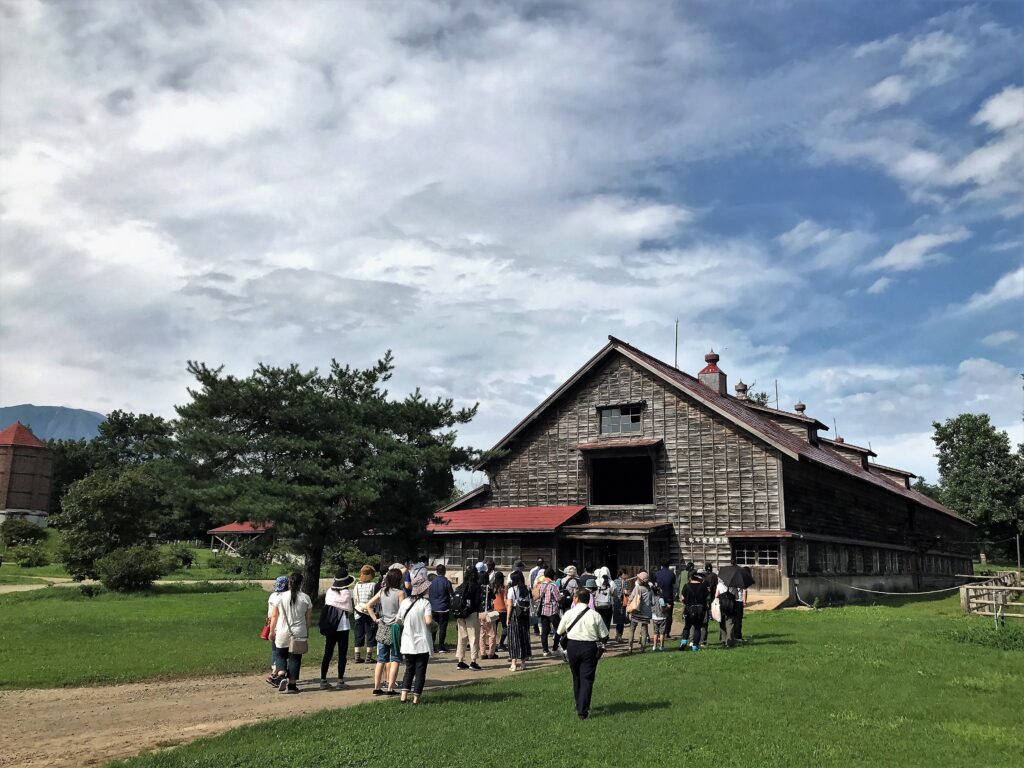
HOW TO ENJOY How to enjoy Makiba Garden
Group Program] Koiwai Farm Bus Tour
Recommended for school trips, excursions and field trips!

Koiwai Farm Bus Tour Model Route [60 min.
まきば園までお越しになったお客様ご利用のバスに当社の専門ガイドが同乗し、ふだんは非公開の重要文化財施設などをめぐります。小岩井自慢のホルスタイン牛にも会えます。
ご案内は、A:酪農コース B:重要文化財コースで回ります。
※A:酪農コースでは牛舎エリアに入る際、車両の「消毒噴霧」を行います。
[Course A] Dairy Farm Course
Departure from Makibaen Parking Lot
(2) Feed base
A facility that produces important feed for cows
③鶴ヶ台牛舎(つるがだいぎゅうしゃ)
A modern barn where about 700 milking cows live and are milked daily.
It is a stress-free environment that does not restrict the cows’ desire to act.
(4) Biomass power generation facility
There is also a biomass power generation facility on the Koiwai Farm. The facility accepts livestock waste from the Koiwai Farm and food scraps from the surrounding area, and uses the methane gas obtained from the methane fermentation process to generate electricity. In addition, the digested liquid (liquid fertilizer) obtained during the process is returned to the farm for grass cultivation, thus practicing sustainable and recycling-oriented agriculture.
(5) Kamimaru Cowshed
About 300 cows live in the “Kamimaru Cowshed,” the birthplace of Koiwai Farm dairy farming, and part of the raw milk produced daily is turned into soft ice cream, pasteurized milk, and other dairy products at the farm’s factory. Nine buildings on the farm, including four active cowsheds built between 1908 and 1935 and two silos said to be the oldest in Japan, have been designated as National Important Cultural Properties.
[Course B] Important Cultural Properties Course
1) Depart from Makibaen Parking Lot
(2) Koiwai Farm Headquarters and other important cultural properties in the Shimomaru area
Since its establishment, this area has been the hub of the farm’s management. There are five important cultural properties, including the headquarters office, described by the poet and children’s story writer Kenji Miyazawa as “the pretentious building of the headquarters.
③旧網張街道
It is an old road where Masaru Inoue conceived the idea of founding a farm in the Meiji era.
(4) Fourth floor warehouse
Built in 1916 (Taisho 5). It is a four-story wooden building for the purpose of drying and storing grain. It was equipped with an electric elevator, which was the latest technology at that time.
(5) Natural refrigerator
These refrigerators were constructed in the Meiji Era, before the introduction of electricity.
(6) Kamimaru Cowshed
About 300 cows live in the “Uemaru Cowshed,” the birthplace of Koiwai Farm dairy farming. Nine buildings, including four active cowsheds built between 1908 and 1935 and two silos said to be the oldest in Japan, have been designated as National Important Cultural Properties.
Points of the tour
A farm guide will ride with you on the bus you use.
Because it is a bus tour, it is not affected by weather conditions (except for bad weather when a warning is issued). (Except for bad weather when a warning is issued.)
■You will be able to see dairy production sites and important cultural assets that are closed to the public.
We hope this tour will provide you with an opportunity to look for hints for a new society through sustainable dairy farming and recycling-oriented business.
The above tour route takes about 60 minutes. Departure time and tour time will be adjusted according to your request.
Notes on application
Reservations must be made in advance. Please apply at least 21 days in advance.
Reservations may not be accepted due to the guide’s schedule or local conditions.
In principle, the number of buses accepted is limited to one.
During the tour of dairy facilities, the buses will pass through a disinfection facility and spray disinfectant on the vehicles for quarantine purposes.
Fees
Dispatch fee for one guide per bus/vehicle: ¥15,000 (tax included); admission fee to Makiba-en: ¥800 for adults/¥300 for children (group rates apply).
